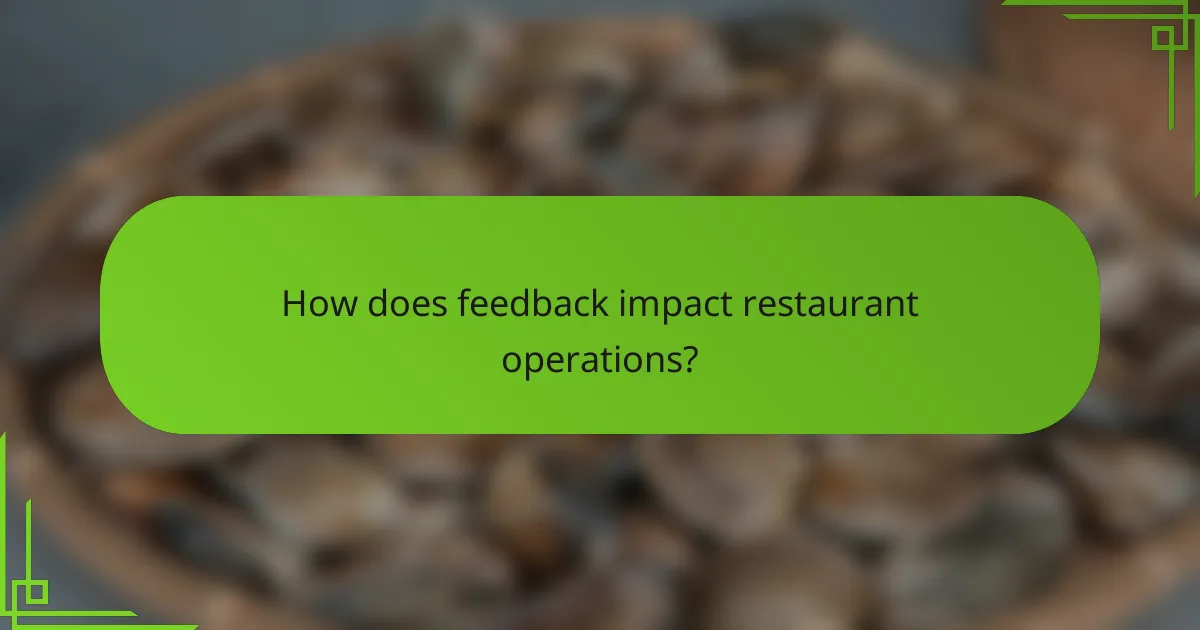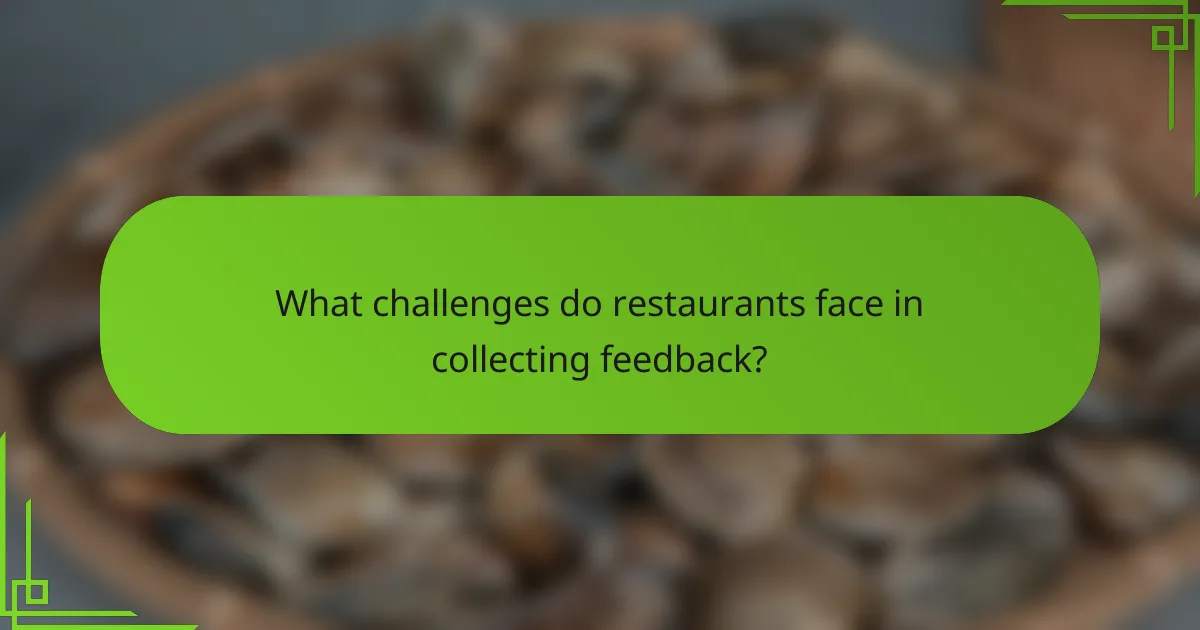Feedback is essential for enhancing dining experiences, as it enables restaurants to grasp customer preferences and identify areas for improvement. By actively soliciting and addressing feedback, establishments can foster a more enjoyable atmosphere and elevate service quality, ultimately driving greater customer loyalty.

How can feedback improve dining experiences in Los Angeles?
Feedback plays a crucial role in enhancing dining experiences in Los Angeles by allowing restaurants to understand customer preferences and areas for improvement. By actively seeking and addressing feedback, establishments can create a more enjoyable atmosphere and better service, ultimately leading to increased patronage.
Enhances customer satisfaction
Collecting feedback helps restaurants identify what customers appreciate and what needs improvement, directly impacting their satisfaction levels. For instance, if diners consistently mention slow service, management can address this issue by optimizing staff schedules or training. Satisfied customers are more likely to return and recommend the restaurant to others.
To effectively enhance satisfaction, restaurants should encourage feedback through comment cards, online surveys, or direct conversations with staff. This proactive approach ensures that customer voices are heard and valued.
Informs menu adjustments
Feedback is essential for informing menu adjustments, allowing restaurants to tailor their offerings to meet customer tastes. If a particular dish receives negative reviews, it may be time to reconsider its ingredients or preparation methods. Conversely, popular items can be highlighted or expanded upon in the menu.
Restaurants in Los Angeles can benefit from seasonal feedback to adapt their menus to local trends and preferences, such as incorporating more plant-based options or highlighting regional flavors. Regularly updating the menu based on customer input keeps the dining experience fresh and engaging.
Strengthens staff training
Feedback can pinpoint areas where staff training may be lacking, helping to improve service quality. For example, if customers frequently comment on unprofessional behavior or lack of product knowledge, management can implement targeted training sessions to address these issues. This investment in staff development leads to a more knowledgeable and courteous team.
Restaurants should consider using feedback as a basis for ongoing training programs, ensuring that staff are equipped to meet customer expectations and provide exceptional service consistently.
Builds customer loyalty
When restaurants actively seek and respond to feedback, they foster a sense of community and engagement with their customers. This responsiveness can significantly enhance customer loyalty, as patrons feel their opinions matter. Establishments that show they care about improving the dining experience are more likely to retain customers over time.
To build loyalty, restaurants can implement loyalty programs that reward customers for providing feedback, such as discounts or exclusive offers. This not only encourages participation but also strengthens the relationship between the restaurant and its patrons.

What methods are effective for gathering dining feedback?
Effective methods for gathering dining feedback include online surveys, in-person comment cards, social media engagement, and follow-up emails. Each method has its unique advantages and can provide valuable insights into customer experiences and preferences.
Online surveys via platforms like SurveyMonkey
Online surveys are a popular method for collecting dining feedback due to their convenience and reach. Platforms like SurveyMonkey allow restaurants to create customized surveys that can be sent to customers via email or shared on social media. This method can yield a high response rate, especially if incentives are offered, such as discounts on future visits.
When designing an online survey, keep questions clear and concise. Aim for a mix of multiple-choice and open-ended questions to gather both quantitative and qualitative feedback. A typical survey should take no more than 5-10 minutes to complete to maintain engagement.
In-person comment cards
In-person comment cards provide immediate feedback from diners while their experience is fresh. These cards can be placed on tables or handed out with the bill, allowing customers to share their thoughts privately. This method can be particularly effective in casual dining settings where customers may feel more comfortable providing feedback directly.
To maximize the effectiveness of comment cards, ensure they are easy to fill out and include specific questions about food quality, service, and atmosphere. Offering a small incentive, like a discount on the next meal, can encourage more customers to participate.
Social media engagement
Social media platforms are powerful tools for gathering dining feedback, as they allow for real-time interaction with customers. Restaurants can monitor mentions, comments, and reviews on platforms like Facebook, Instagram, and Twitter to gauge customer sentiment. Engaging with diners through comments or direct messages can also foster a sense of community.
To effectively use social media for feedback, actively encourage customers to share their experiences by creating hashtags or running contests. Responding promptly to both positive and negative feedback shows that the restaurant values customer opinions and is committed to improvement.
Follow-up emails
Follow-up emails are an effective way to gather feedback after a dining experience. Sending a personalized email thanking customers for their visit and inviting them to share their thoughts can enhance customer loyalty and provide valuable insights. This method allows for more detailed responses compared to other methods.
When crafting follow-up emails, keep the message brief and include a link to an online survey or a direct request for feedback. Consider timing the email to arrive within a few days of the visit, as this helps ensure the experience is still fresh in the customer’s mind. Including a small incentive, like a discount on their next visit, can further encourage responses.

What are the key attributes of effective feedback?
Effective feedback is characterized by its specificity, timeliness, and actionability. These attributes ensure that the feedback is clear, relevant, and useful for making improvements in a dining experience.
Specificity of comments
Specificity in feedback means providing detailed observations rather than vague statements. For instance, instead of saying “the food was bad,” a more specific comment would be “the chicken was overcooked and dry.” This clarity helps the restaurant understand exactly what needs to be addressed.
When giving feedback, focus on particular dishes, service aspects, or ambiance elements. Mentioning specific menu items or service interactions allows the establishment to pinpoint areas for improvement.
Timeliness of responses
Timeliness refers to providing feedback shortly after the dining experience. Immediate feedback is often more relevant and can lead to quicker adjustments. For example, sharing your thoughts while still at the restaurant can prompt immediate action from the staff.
Consider the context; feedback given within a few hours or days is generally more impactful than comments made weeks later. This approach ensures that the details are fresh in both the diner’s and the restaurant’s minds.
Actionability of suggestions
Actionability means that the feedback includes practical suggestions for improvement. Instead of merely stating what was wrong, effective feedback should propose solutions, such as recommending a different cooking method or suggesting menu changes.
For instance, if a dish lacks seasoning, suggesting specific spices or flavors can help the kitchen make necessary adjustments. This type of constructive feedback not only identifies issues but also empowers the restaurant to enhance the dining experience.

How does feedback impact restaurant operations?
Feedback significantly influences restaurant operations by providing insights into customer satisfaction and areas needing improvement. It helps restaurants adapt their services, offerings, and marketing strategies to better meet customer expectations.
Improves service quality
Customer feedback directly enhances service quality by highlighting strengths and weaknesses in staff performance. For example, if diners consistently mention slow service, management can implement training programs to address this issue.
Regularly collecting feedback through surveys or comment cards allows restaurants to identify specific areas for improvement, such as wait times or staff friendliness. This proactive approach can lead to higher customer satisfaction and repeat business.
Drives menu innovation
Feedback plays a crucial role in menu innovation by revealing customer preferences and trends. Restaurants can analyze comments about popular dishes or requests for new options, guiding them to update their menus accordingly.
For instance, if patrons frequently request vegetarian or gluten-free options, a restaurant might introduce new dishes that cater to these dietary needs. This responsiveness not only meets customer demands but can also attract a broader audience.
Enhances marketing strategies
Utilizing feedback effectively can refine marketing strategies by aligning promotional efforts with customer interests. Positive reviews can be highlighted in advertisements, while constructive criticism can inform targeted campaigns aimed at specific demographics.
Additionally, engaging with customers through social media platforms and responding to their feedback can strengthen brand loyalty. Restaurants that showcase their commitment to customer satisfaction often see an increase in both foot traffic and online engagement.

What challenges do restaurants face in collecting feedback?
Restaurants encounter several challenges in collecting feedback, primarily due to customer engagement issues, the prevalence of negative responses, and difficulties in data analysis. These obstacles can hinder the effectiveness of feedback mechanisms and limit actionable insights.
Lack of customer engagement
Many restaurants struggle with low customer participation in feedback initiatives. Factors such as time constraints and lack of incentives can deter patrons from sharing their experiences. To improve engagement, restaurants can offer small discounts or loyalty points for completed surveys.
Additionally, simplifying the feedback process through quick online forms or in-person comment cards can encourage more customers to participate. Ensuring that feedback requests are timely, such as right after a meal, can also boost response rates.
Overwhelming negative responses
Restaurants often receive a disproportionate amount of negative feedback compared to positive comments. This can create a skewed perception of customer satisfaction, leading management to focus excessively on complaints rather than overall performance. It’s crucial to balance feedback by actively soliciting positive responses as well.
To mitigate the impact of negative feedback, restaurants can implement follow-up questions to understand the context of complaints better. This approach allows for constructive criticism while also highlighting areas of strength.
Difficulty in analyzing data
Analyzing feedback data can be complex, especially when it comes from various sources like online reviews, comment cards, and social media. Restaurants may find it challenging to identify trends or actionable insights without a systematic approach to data collection and analysis. Utilizing specialized software can streamline this process.
Establishing clear metrics for success, such as customer satisfaction scores or Net Promoter Scores (NPS), can help restaurants focus their analysis. Regularly reviewing feedback and categorizing it into themes can also simplify the evaluation process and inform operational improvements.


